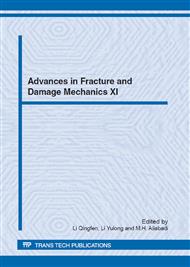p.581
p.585
p.589
p.593
p.597
p.601
p.605
p.609
p.613
Improvement of Fatigue Crack Growth Behavior in the Case of the Cracked Specimen with Relatively Narrow Width
Abstract:
The improvement of acceleration behavior of crack growth was investigated with constant stress amplitude under negative stress ratio R=-1. Then a technical method to detect the fatigue crack growth was discussed. For example, when the stress amplitude exceeds a critical value, crack growth rate of overloaded specimen became higher than that of baseline which was obtained by crack growth test without applying overload. In some experimental cases, the acceleration of crack growth was observed and that could be happened on practical cases. Stop-holes were drilled at crack tips or in the vicinity of crack tips to remove the plastic zone and the effect of that on crack growth behavior were investigated. Also, steel pins were inserted into the stop-holes and its effect was discussed. Finite element method (FEM) was used to analyze the stress concentration at the edge of stop-holes. Positions of center of the stop-holes were varied at different distance from the crack tips to investigate the effect of stop-holes on fatigue crack growth. Also, stress intensity of base and stop-holed specimen was calculated. Then, the effect of stop-hole was discussed by both the experimental and analytical results. Specially, it was discussed whether the crack growth behavior was improved or not in the case of relatively smaller width specimen.
Info:
Periodical:
Pages:
597-600
Citation:
Online since:
November 2012
Authors:
Price:
Сopyright:
© 2013 Trans Tech Publications Ltd. All Rights Reserved
Share:
Citation:


